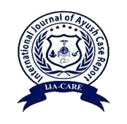Effect Hibiscus sabdariffa L. (Ambulpala), Rathkaralheba Kashaya and Roghan-e-Khas Guda Varti in Raktarshas (Bleeding Haemorrhoids) - A Case study
Abstract
According to Ayurveda, Arshas is a disease which tortures patient’s vital force (Prana) as an enemy. Raktarshas is a type of Arsha with pile masses like Nyagrodha Praroha (aerial prop roots of banyan tree), Kakanantika (seeds of Abrus precatorius), Vidruma (corals) and presents Pitta Lakshana (the clinical features of Pittaja Arshas). Raktarshas can be corelated with bleeding haemorrhoids. The commonest symptoms of bleeding haemorrhoids are painless bleeding from the anal area, anal itching, pain in the anal area, swelling and feeling of rectal fullness or a lump at the anus. Sri Lankan traditional physician family Weerasinghe uses Hibiscus sabdariffa L (Ambulpala) as an Anulomana Dravya in treatment of Raktarshas. Sri Lankan traditional medical practitioners recommend Rathkaralheba Kashaya to treat patients suffering from Raktarshas. In Ayurveda hospitals Roghan-e-Khas is frequently used in treating haemorrhoids. So far, no known scientific study has been conducted to evaluate the effects of these treatments. Therefore, the present study was undertaken. A 55 years old female with a 12-year history of Raktarshas (bleeding heamorrhoids) was treated with this treatment regimen for 15 days. On Day 1 Anulomana (medicaments which restores and facilitates the physiological direction of various flows within the body like flatus and stool) was conducted with Hibiscus sabdariffa L. and from Day 2 to 15 the patient was treated with oral administration of Rathkaralheba Kashaya with rectal administration of Roghan-e-Khas Guda Varti. The response to the treatment was recorded and therapeutic effects were evaluated through symptomatic relief. On day 15, it was observed that Kandu, Ruja, Daha, Rectal fullness, Raktasrava were completely relieved and number of pile masses were partially relieved. It is concluded that selected treatment regimen is effective in Raktarshas (bleeding haemorrhoids).

This work is licensed under a Creative Commons Attribution-NonCommercial-NoDerivatives 4.0 International License.

